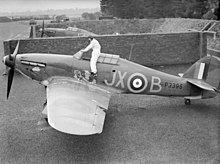Blast pen
This article has multiple issues. Please help improve it or discuss these issues on the talk page. (Learn how and when to remove these template messages)
|
It has been suggested that this article be merged with Revetment (aircraft). (Discuss) Proposed since November 2014. |


A blast pen was a specially constructed E-shaped double bay at British RAF World War 2 fighter stations, being either 150 feet (46 m) or 190 feet (58 m) wide and 80 feet (24 m) front-to-back, accommodating aircraft for safe-keeping against bomb blasts and splinters during enemy air-attacks.
Although the pens were open to the sky the projecting sidewalls preserved the aircraft from lateral damage, with 12-inch (300 mm) thick, 9 feet (2.7 m) high concrete centres, and banked-up earth on either side, forming a roughly triangular section 18 feet (5.5 m) wide at their base. The longer spine section behind the parking areas usually encloses a narrow corridor for aircrew and servicing personnel to use as an air raid shelters.
Examples may still be seen at the present Kenley Aerodrome and at North Weald Airfield close to "The Squadron" bar, some pens have had their second bay removed over the years, thus becoming U-shaped.There are also a large number at the former RAF Catterick by the A1, and some at RAF Wittering. The Imperial War Museum Duxford has one that is accessible to the public. Whilst common on Fighter Command airfields, other RAF Stations such as RAF Benson and RAF Brize Norton did not have any blast pens.
See also
Bibliography
- Flint, Peter (1985). R.A.F. Kenley. Terence Dalton Limited. p. 158. ISBN 0-86138-036-3.
External links
![]() Media related to Blast pens at Wikimedia Commons
Media related to Blast pens at Wikimedia Commons
